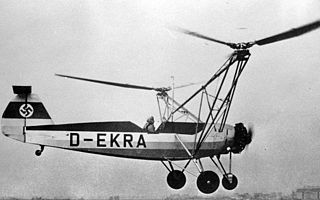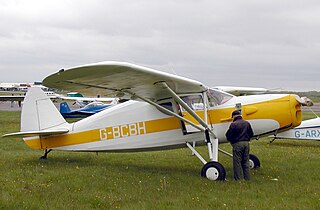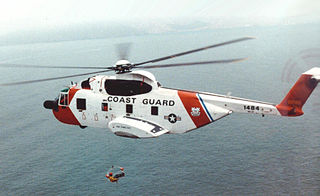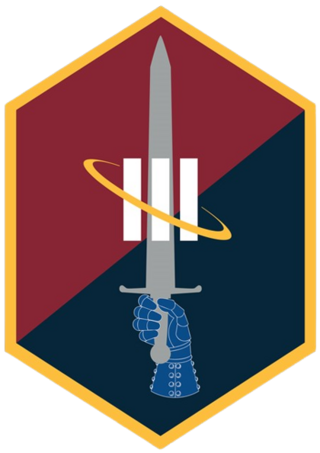
Promethium is a chemical element with the symbol Pm and atomic number 61. All of its isotopes are radioactive; it is extremely rare, with only about 500–600 grams naturally occurring in Earth's crust at any given time. Promethium is one of only two radioactive elements that are followed in the periodic table by elements with stable forms, the other being technetium. Chemically, promethium is a lanthanide. Promethium shows only one stable oxidation state of +3.

61 Cygni is a binary star system in the constellation Cygnus, consisting of a pair of K-type dwarf stars that orbit each other in a period of about 659 years. Of apparent magnitude 5.20 and 6.05, respectively, they can be seen with binoculars in city skies or with the naked eye in rural areas without light pollution.

The M61 Vulcan is a hydraulically, electrically, or pneumatically driven, six-barrel, air-cooled, electrically fired Gatling-style rotary cannon which fires 20 mm × 102 mm rounds at an extremely high rate. The M61 and its derivatives have been the principal cannon armament of United States military fixed-wing aircraft for over sixty years.

The fennec fox is a small crepuscular fox native to the deserts of North Africa, ranging from Western Sahara and Mauritania to the Sinai Peninsula. Its most distinctive feature is its unusually large ears, which serve to dissipate heat and listen for underground prey. The fennec is the smallest fox species. Its coat, ears, and kidney functions have adapted to the desert environment with high temperatures and little water. It mainly eats insects, small mammals and birds. The fennec has a life span of up to 14 years in captivity and about 10 years in the wild. Its main predators are the Verreaux's eagle-owl, jackals and other large mammals. Fennec families dig out burrows in the sand for habitation and protection, which can be as large as 120 m2 (1,300 sq ft) and adjoin the burrows of other families. Precise population figures are not known but are estimated from the frequency of sightings; these indicate that the fennec is currently not threatened by extinction. Knowledge of social interactions is limited to information gathered from captive animals. The fennec's fur is prized by the indigenous peoples of North Africa, and it is considered an exotic pet in some parts of the world.

The Sikorsky SH-3 Sea King is an American twin-engined anti-submarine warfare (ASW) helicopter designed and built by Sikorsky Aircraft. A landmark design, it was one of the first ASW rotorcraft to use turboshaft engines.

The Focke-Wulf Fw 61 is often considered the first practical, functional helicopter, first flown in 1936. It was also known as the Fa 61, as Focke began a new company—Focke-Achgelis—in 1937.

The Northrop P-61 Black Widow is a twin-engine United States Army Air Forces fighter aircraft of World War II. It was the first operational U.S. warplane designed as a night fighter.
In mathematics, a double Mersenne number is a Mersenne number of the form

The Boeing C-135 Stratolifter is a transport aircraft derived from the prototype Boeing 367-80 jet airliner in the early 1950s. It has a narrower fuselage and is shorter than the 707. Boeing gave the aircraft the internal designation of Model 717. Since the first one was built in August 1956, the C-135 and its variants have been a fixture of the United States Air Force.
T.61 is an ITU-T Recommendation for a Teletex character set. T.61 predated Unicode, and was the primary character set in ASN.1 used in early versions of X.500 and X.509 for encoding strings containing characters used in Western European languages. It is also used by older versions of LDAP. While T.61 continues to be supported in modern versions of X.500 and X.509, it has been deprecated in favor of Unicode. It is also called Code page 1036, CP1036, or IBM 01036.

The B61 nuclear bomb is the primary thermonuclear gravity bomb in the United States Enduring Stockpile following the end of the Cold War. It is a low to intermediate-yield strategic and tactical nuclear weapon featuring a two-stage radiation implosion design.

The Fairchild Model 24, also called the Fairchild Model 24 Argus and UC-61 Forwarder, is a four-seat, single-engine monoplane light transport aircraft designed by the Fairchild Aviation Corporation in the 1930s. It was adopted by the United States Army Air Corps as UC-61 and also by the Royal Air Force. The Model 24 was itself a development of previous Fairchild models and became a successful civil and military utility aircraft.

The Northrop F-15 Reporter was an American unarmed photographic reconnaissance aircraft. Based on the Northrop P-61 Black Widow night fighter, it was the last piston-powered photo-reconnaissance aircraft designed and produced for the United States Air Force. Though produced in limited quantities, and with a relatively short service life, the F-15's aerial photographs of the Korean Peninsula would prove vital in 1950, when North Korea invaded the south.

The Sikorsky S-61R is a twin-engine helicopter used in transport or search and rescue roles. A developed version of the S-61/SH-3 Sea King, the S-61R was also built under license by Agusta as the AS-61R. The S-61R served in the United States Air Force as the CH-3C/E Sea King and the HH-3E Jolly Green Giant, and with the United States Coast Guard as the HH-3F, nicknamed "Pelican".

NA61/SHINE is a particle physics experiment at the Super Proton Synchrotron (SPS) at the European Organization for Nuclear Research (CERN). The experiment studies the hadronic final states produced in interactions of various beam particles with a variety of fixed nuclear targets at the SPS energies.

NASA Astronaut Group 9 was a group of 19 NASA astronauts announced on May 29, 1980, and completed their training by 1981. This group was selected to supplement the 35 astronauts that had been selected in 1978, and marked the first time that non-Americans were trained as mission specialists with the selections of ESA astronauts Claude Nicollier and Wubbo Ockels. In keeping with the previous group, astronaut candidates were divided into pilots and mission specialists, with eight pilots, eleven mission specialists, and two international mission specialists within the group.

Space Base Delta 3 is a United States Space Force unit assigned to the Space Systems Command. The unit is stationed at Los Angeles Air Force Base, California. It is the successor to the 61st Air Base Group of the United States Air Force and the Los Angeles Garrison, which existed through the first two years of the Space Force. The garrison operates Los Angeles Air Force Base and supports Space Systems Command.

Avro is a row-oriented remote procedure call and data serialization framework developed within Apache's Hadoop project. It uses JSON for defining data types and protocols, and serializes data in a compact binary format. Its primary use is in Apache Hadoop, where it can provide both a serialization format for persistent data, and a wire format for communication between Hadoop nodes, and from client programs to the Hadoop services. Avro uses a schema to structure the data that is being encoded. It has two different types of schema languages; one for human editing and another which is more machine-readable based on JSON.

C/2015 ER61 (PanSTARRS) is a comet, inner Oort cloud object. When classified as a minor planet, it had the fourth-largest aphelion of any known minor planet in the Solar System, after 2005 VX3, 2012 DR30, and 2013 BL76. It additionally had the most eccentric orbit of any known minor planet, with its distance from the Sun varying by about 99.9% during the course of its orbit, followed by 2005 VX3 with an eccentricity of 0.9973. On 30 January 2016, it was classified as a comet when it was 5.7 AU from the Sun. It comes close to Jupiter, and a close approach in the past threw it on the distant orbit it is on now.

















